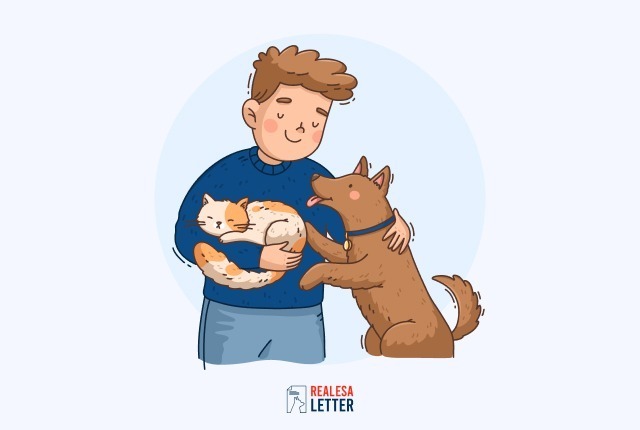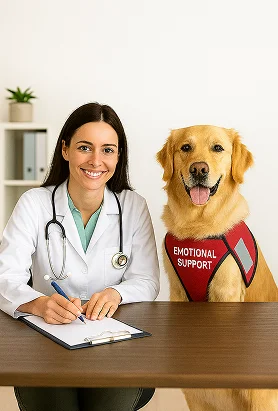Living with anxiety can feel like a constant uphill battle. Between racing thoughts, physical tension, and emotional overwhelm, it’s easy to feel stuck in a cycle of worry.
In this guide, we’ll explore how emotional support animals help ease anxiety. You’ll learn how they differ from service animals, the unique benefits they offer, and the steps to bring one into your life.
What are Emotional Support Animals for Anxiety?
An emotional support animal is a pet that helps people manage anxiety and other mental health conditions. This can include anxiety disorder, depression, post-traumatic stress disorder, and attention deficit hyperactivity disorder.
The main role of an ESA is to provide comfort and emotional stability. They do this through companionship, affection, and a calming presence. Unlike service animals, ESAs are not specially trained to perform specific tasks for a disability. Their value comes from the emotional support they give.
Under the Fair Housing Act (FHA), ESAs are allowed in housing where pets are normally not permitted. However, they do not have the same public access rights as service animals under the Americans with Disabilities Act.
What is Anxiety and Its Symptoms?
Anxiety is a mental health condition marked by excessive fear, worry, or nervousness. It goes beyond everyday stress and can interfere with work, relationships, and daily activities. Anxiety may be triggered by specific situations or may occur without a clear cause.
Common symptoms of anxiety include:
- Persistent nervousness or tension
- Racing heart and rapid breathing
- Trouble concentrating
- Restlessness and irritability
- Sleep disturbances
- Muscle tension or trembling
- Avoidance of social situations
When anxiety becomes overwhelming, it activates the body’s stress response. This releases stress hormones like cortisol, which, over time, can harm both mental and physical health.
It’s also important to note the difference between general anxiety and social anxiety. General anxiety can happen in many areas of life, while social anxiety is specifically linked to fear or discomfort in social situations.
How an ESA Can Help with Managing Anxiety
The benefits of emotional support animals can be life-changing when you’re dealing with anxiety. They offer comfort and support in ways that go beyond words.
Soothing the Stress Response
Spending just 10 minutes with an ESA can lower stress hormones like cortisol and increase oxytocin, the “love hormone” that helps you feel calm and connected. This has been seen in studies measuring hormone changes during human-animal interaction. Additionally, oxytocin’s stress-buffering role is well-documented in wider research on human-animal interaction.
A landmark pilot study by the University of Toledo found that ESAs provided quantifiable benefits, reducing anxiety, depression, and loneliness, for individuals with serious mental illness.
Encouraging Healthy Daily Routines
Having an ESA means you’re responsible for another living being. That responsibility naturally adds structure to your day. Feeding, grooming, and playtime create a consistent routine, which can be especially helpful for those with anxiety disorders.
Many ESA owners find that this sense of purpose boosts motivation and helps them take better care of themselves, too.
Grounding and Emotional Regulation
When anxiety starts to spiral, ESAs can help ground you in the present moment. Physical touch, whether it’s stroking your cat’s fur or cuddling your dog, helps regulate breathing, lowers arousal, and eases anxious thoughts. This shared sense of calm is known as co-regulation, and it’s a powerful tool for managing symptoms of anxiety.
Boosting Social Connection
ESAs can help break down social barriers. Dogs, for example, often spark friendly interactions on walks. Even sharing pet stories or tips with fellow animal lovers can help reduce feelings of isolation.
For those struggling with social anxiety, these small moments of connection can be a gentle way to build confidence.
Support in Challenging Life Changes
Major transitions like starting college, moving to a new city, or recovering from trauma can make anxiety worse. Thanks to protections under the FHA, ESAs can live with you in housing that normally doesn’t allow pets. Having that familiar comfort close by can make big life changes feel more manageable.
Promoting Physical Activity
Regular physical activity is proven to reduce anxiety and improve mood. With an ESA, especially a dog, walks and playtime become part of your daily life. This movement helps lower cortisol, offers a healthy distraction from worry, and improves physical health, which in turn supports better mental health. Other ESAs, like horses, have also been shown to help riders feel calmer and more focused.
Best Emotional Support Animals for Anxiety
When it comes to ESAs, dogs and cats might be the first that come to mind, but they’re not the only ones. The best ESA for you depends on your personality, lifestyle, and what kind of comfort you’re looking for. Here are some great options to consider:
1. Dogs
Dogs are loyal, affectionate, and often deeply in tune with their owners’ emotions. They encourage daily physical activity through walks and play, which helps reduce anxiety naturally. Certain breeds are especially known for their calm, comforting nature:
- Labrador Retriever – Gentle, patient, and great for families.
- Cavalier King Charles Spaniel – Small, affectionate lap dogs that thrive on companionship.
- Golden Retriever – Friendly, adaptable, and great with people of all ages.
2. Cats
Cats are independent yet incredibly comforting. They’re perfect if you want a lower-maintenance ESA but still love snuggles. Their purring has even been linked to calming effects and lower stress hormones. Breeds to consider:
- Ragdoll – Relaxed and affectionate, often called “puppy-like” cats.
- British Shorthair – Gentle and low-energy, ideal for calm homes.
- Maine Coon – Big, fluffy, and friendly, often very social.
3. Rabbits
Rabbits are quiet, gentle, and love routine, which can be reassuring for someone with an anxiety disorder. They enjoy petting and interaction, but don’t require the same activity level as a dog. Popular breeds include:
- Holland Lop – Known for their sweet, easygoing personalities.
- Mini Rex – Soft fur and a curious, calm demeanor.
4. Guinea Pigs
Small but surprisingly social, guinea pigs make great ESAs for people in small spaces. They respond well to gentle handling and have a soothing, soft squeak that can lift your mood. Popular breeds:
- Abyssinian – Playful and curious with a unique coat.
- American – Calm and friendly, great for beginners.
5. Birds
Birds like parrots, cockatiels, and parakeets can provide constant companionship through their chatter, songs, and playful nature. Many bond strongly with their owners and can be a comforting presence. Recommended species:
- Budgerigar (Budgie) – Small, friendly, and easy to care for.
- Cockatiel – Gentle, affectionate, and capable of mimicking sounds.
6. Miniature Horses
For people with access to space and proper care, miniature horses can be incredible ESAs. They are calm, highly trainable, and have been used in therapeutic settings to reduce anxiety and promote emotional regulation.
7. Hamsters
Hamsters are tiny, low-maintenance companions that can be soothing to watch and interact with. While they’re not as interactive as dogs or cats, their presence can still bring comfort, especially for those who prefer a quieter animal.
Pro Tip: Choosing the right ESA isn’t just about species; it’s about matching your personality, environment, and emotional needs with the right animal and breed. Whether you want a playful partner or a calm, cuddly companion, there’s an ESA out there for you.
How to Get an Emotional Support Animal for Anxiety
Getting an ESA involves a few important steps:
- Consult a Licensed Mental Health Professional – They will assess your symptoms and decide if an ESA is right for you. If you need task-trained support, you may qualify for a PSD letter instead.
- Choose the Right Animal – Think about temperament, care needs, and compatibility with your lifestyle.
- Provide Proper Care – ESAs don’t need specialized training to perform tasks, but basic obedience and socialization are helpful.
- Understand Your Rights – Know your protections under the housing act and your limits under the Americans with Disabilities Act.
How to Get an ESA Letter for Anxiety
An ESA letter is a formal document from a licensed mental health professional confirming that you have a qualifying mental health condition and that an ESA can help ease your symptoms. This letter is essential for securing your rights under laws like the FHA.
At RealESALetter.com, we’ve made the process quick, simple, and stress-free:
- Take Our Free Qualification Quiz – Start by filling out a short online questionnaire to see if you may qualify for an ESA.
- Connect with a Licensed Professional – If you meet the criteria, we’ll link you with a qualified mental health provider for an evaluation.
- Confirm Your Order – Once approved, finalize your request for the letter.
- Get Your ESA Letter Fast – Receive your certified ESA letter from a PCP or LMHP digitally within 24 hours. Your printed copy will arrive at your door in about 3 days.
With RealESALetter.com, you can handle the entire process from home, with no waiting rooms, no complicated steps, and no unnecessary delays. And if you ever need to renew your ESA letter, the process is just as simple.
You can even view a sample ESA letter to know exactly what to expect.
Final Thoughts!
Living with anxiety can be overwhelming, but you don’t have to manage it alone. An emotional support animal can offer more than just companionship; it can provide structure, comfort, and a sense of security during your toughest days.
If you believe an ESA could make a difference in your life, reach out to a licensed mental health professional to explore your options. Your perfect companion might be out there right now, ready to help you face each day with more peace and a little extra love.
Ready to take the next step?
At RealESALetter.com, you can get your official emotional support animal letter quickly and easily. Start with our free qualification quiz, connect with a licensed provider, and receive your certified letter in as little as 24 hours. Your journey to a calmer, more supported life can start today.
Pricing
PSD Letter
Reviews
ESA By States
ESA Laws
Resources




